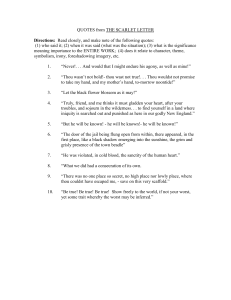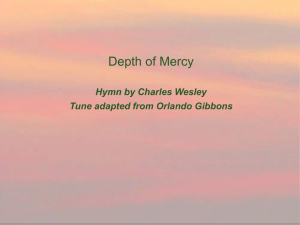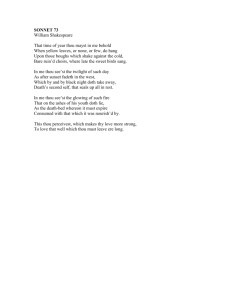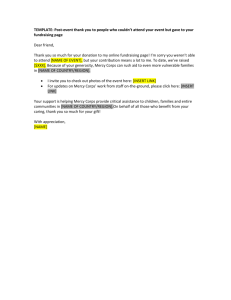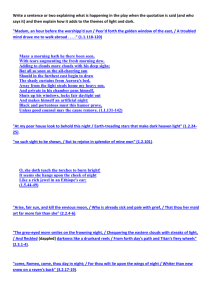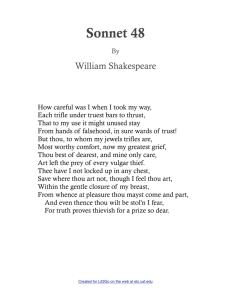Annotation John Donne*s Holy Sonnet IX
advertisement
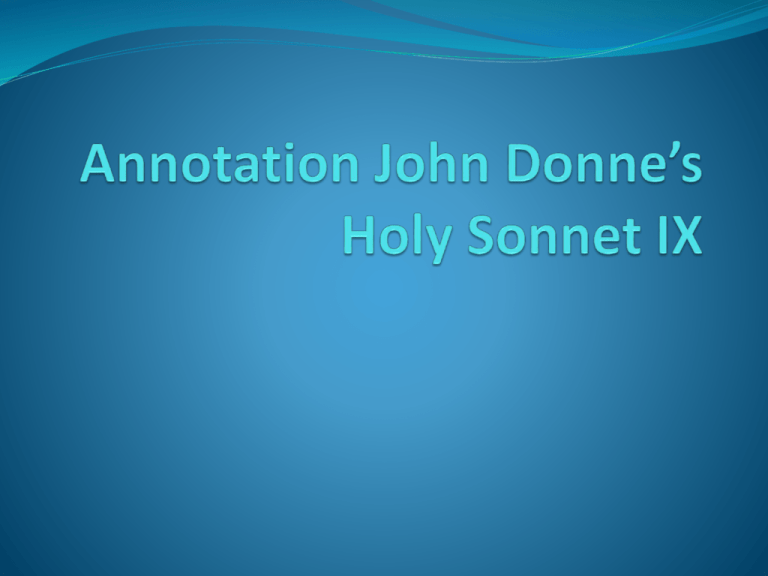
Holy Sonnet IX If poisonous minerals, and if that tree, Whose fruit threw death on (else immortal) us, If lecherous goats, if serpents envious Cannot be damn'd, alas ! why should I be ? Why should intent or reason, born in me, Make sins, else equal, in me more heinous ? And, mercy being easy, and glorious To God, in His stern wrath why threatens He ? But who am I, that dare dispute with Thee ? O God, O ! of Thine only worthy blood, And my tears, make a heavenly Lethean flood, And drown in it my sin's black memory. That Thou remember them, some claim as debt ; I think it mercy if Thou wilt forget. Structure 1 If poisonous minerals, and if that tree, 2 Whose fruit threw death on (else immortal) us, 3 If lecherous goats, if serpents envious 4 Cannot be damn'd, alas ! why should I be ? 5 Why should intent or reason, born in me, 6 Make sins, else equal, in me more heinous ? 7 And, mercy being easy, and glorious 8 To God, in His stern wrath why threatens He ? 9 But who am I, that dare dispute with Thee ? 10 O God, O ! of Thine only worthy blood, 11 And my tears, make a heavenly Lethean flood, 12 And drown in it my sin's black memory. 13 That Thou remember them, some claim as debt ; 14 I think it mercy if Thou wilt forget. Poetic Traditions Meditative poetry Sonnet 9 Structure oSonnet has a rhyme scheme of ABBAABBAACCDEE oShows emphasis on line 12 oEmphasis on lines 13 and 14 also because of change in rhyme scheme oHas structure of meditative poetry: 1) focus of setting 2) analysis of points 3) colloquies (dialogue with God) oDonne is often known for using parts of meditative poetry structure, usually colloquies. oSonnet 9 uses trifold of meditative poetry while using traditional rhyming scheme and metaphors of traditional poetry oFocus of sin in the Garden, followed by analysis of reasoning that are directed to God Religious References 1 If poisonous minerals, and if that tree, 2 Whose fruit threw death on (else immortal) us, 3 If lecherous goats, if serpents envious 4 Cannot be damn'd, alas ! why should I be ? 5 Why should intent or reason, born in me, 6 Make sins, else equal, in me more heinous ? 7 And, mercy being easy, and glorious 8 To God, in His stern wrath why threatens He ? 9 But who am I, that dare dispute with Thee ? 10 O God, O ! of Thine only worthy blood, 11 And my tears, make a heavenly Lethean flood, 12 And drown in it my sin's black memory. 13 That Thou remember them, some claim as debt ; 14 I think it mercy if Thou wilt forget. Uses multiple religious references within the poem Questions ways of God, and then changes tone in line 8 to a tone of acceptance and repentance. Structure and questions according to refer to Romans 8. Uses same technique of switching for first person plural pronoun to first person singular pronouns to get audience to sympathizes with him and repent to God. Topic of questioning also appears in Romans 8. Tone Change in Tone from line 8 to 9 May have derived from purpose of structure to reference Romans 8 1 If poisonous minerals, and if that tree, 2 Whose fruit threw death on (else immortal) us, Purpose to help reader 3 If lecherous goats, if serpents envious sympathize with speaker 4 Cannot be damn'd, alas ! why should I be ? Uses meditative poetry style of 5 Why should intent or reason, born in me, 6 Make sins, else equal, in me more heinous ? dramatic statements 7 And, mercy being easy, and glorious Switches from questioning to 8 To God, in His stern wrath why threatens He ? explanation where speaker is 9 But who am I, that dare dispute with Thee ? begging for mercy 10 O God, O ! of Thine only worthy blood, 11 And my tears, make a heavenly Lethean flood, Connects with Donne’s past 12 And drown in it my sin's black memory. Troubling past shines through in 13 That Thou remember them, some claim as debt ; questioning, and portrays 14 I think it mercy if Thou wilt forget. Donne’s theme of creating melancholic tones compared to spiritual enlighting. Metaphors Use of metaphysical Displays different metaphors Compares sin to poisonous minerals, lusty goats, and serpents Compares grace to flood imagery than imagery provided usually imagined when talking, fall of man, grace, and mercy Vs. Works Cited Archer, Stanley. "Meditation and the Structure of Donne's "Holy Sonnets"“ ELH 28.2 (1961): 137-147. JSTOR. The Johns Hopkins University Press. Web. March 2010 Chong, Kenneth. "Blood, Sweat, and Tears: Self-Chastisement in Donne's 'If Poysonous Mineralls'." Renaissance and Reformation/Renaissance et Réforme 29.4 (2005): 4155. MLA International Bibliography. EBSCO. Web. 2 Mar. 2010. Kuchar, Gary. "Petrarchism and Repentance in John Donne's Holy Sonnets." Modern Philology: Critical and Historical Studies in Literature, Medieval Through Contemporary 105.3 (2008): 535-569. MLA International Bibliography. EBSCO. Web. 2 Mar. 2010. Trevor, Douglas. "John Donne and Scholarly Melancholy." Studies in English Literature 1500-1900 40.1 (2000): 81-102. Winter. Project Muse. Web. 2 March 2010

